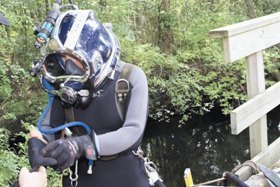
A scuba diver gets ready to inspect the Harris Mill dam in the Pawtuxet River, which developers aim to use to generate hydroelectric power.
Eight months ago, Gov. Donald L. Carcieri pledged in his State of the State address to have 15 percent of Rhode Island’s electricity come from wind power by 2011. The idea was to make the state less dependent on fossil fuels and out-of-state power plants.
Now, with plans for three hydroelectric power generators, and the potential for more being considered, Carcieri has raised his target for renewable energy generation to 20 percent.
“We are a pawn in the global energy markets, and I don’t like that,” he said at a press briefing Sept. 8. The answer, as he sees it, is to harness the power of the wind, rivers and waves – and the state is helping finance projects that will do just that.
At the Harris Mill complex in Coventry, developers have begun a $1.5 million project to repair or replace existing hydroelectric equipment and a steam generator. With power from the Pawtuxet River, the new facilities would generate 1.5 megawatts of electricity, or enough to power more than 800 homes, said Gerald Diodati, owner of Rhode Island Construction Services Inc., the lead developer for the project.
To finance the plan, the developer received a $500,000 loan from the R.I. Office of Energy Resources, and the R.I. Economic Development Corporation has agreed to back a $500,000 private bank loan. The remaining $500,000 is coming from the developers, who also plan to convert the 156-year-old mill complex into 160 to 170 apartments and condos, Diodati said.
The developer has agreed to give 2 cents per kilowatt hour from the sale of its renewable energy credits to the state Renewable Energy Fund. The agreement will provide the energy fund with about $120,000 per year for future projects, said Andrew C. Dzykewicz, the governor’s chief energy advisor and head of the Office of Energy Resources.
The governor’s office said Rhode Island Construction Services also will pay the same amount to the Pawtuxet River Authority, to help finance upkeep of river dams needed for the hydroelectric equipment.
Another hydroelectric turbine is to be installed along the Pawtuxet at the Royal Mills complex in West Warwick. The Office of Energy Resources gave the developer, Struever Bros. Eccles & Rouse Inc. of Baltimore, a $12,000 grant to study the feasibility of the project. A turbine has been ordered and is expected to power only the development’s common areas, Dzykewicz said.
A similar effort is under way as part of the renovation of the American Tourister complex on the Palmer River in Warren. The state put up $20,000 for a project study, and the developer has agreed to give the state 1 percent of its renewable energy credits in return, Dzykewicz said.
In addition, the state energy office is working with the R.I. Department of Environmental Management to identify which dams, among a total of 650 in the state, could be used for hydroelectric power. Hydroelectric projects here could generate about 10 megawatts per year, or about 1 percent of the total electricity used in the state, Dzykewicz said.
A separate study to find sites for wind turbines in the state is expected to be finished by the end of the year, Dzykewicz said, but the feasibility of the governor’s 15-percent goal has not yet been determined. Daniel Mendelsohn, a lead engineer with Applied Technology & Management Inc. in Newport, which was hired to conduct the study, called the goal “aggressive.”
Dzykewicz has said several companies are interested in the wind initiative, dubbed RI WINDS, and the goal is to begin construction of one or more wind farms by 2009. Cape Wind Associates, the Boston-based firm behind the project to put 130 wind turbines in Nantucket Sound, voiced interest in the Rhode Island project earlier this year.
The state now generates nearly 1.5 percent of its some 1,000 megawatts of annual electricity use from renewable sources, Dzykewicz said. Those sources include a wind turbine at Portsmouth Abbey School in Portsmouth, which produces about 220 kilowatts per year, and generators powered by methane gas at the state’s Central Landfill in Johnston, which produce about 12 megawatts per year.
Meanwhile, an Australia-based company called Energetech has been testing wave-powered generators in Point Judith Sound for more than a year. Dzykewicz said the company is seeking approval from the Federal Energy Regulatory Commission for a project here.











